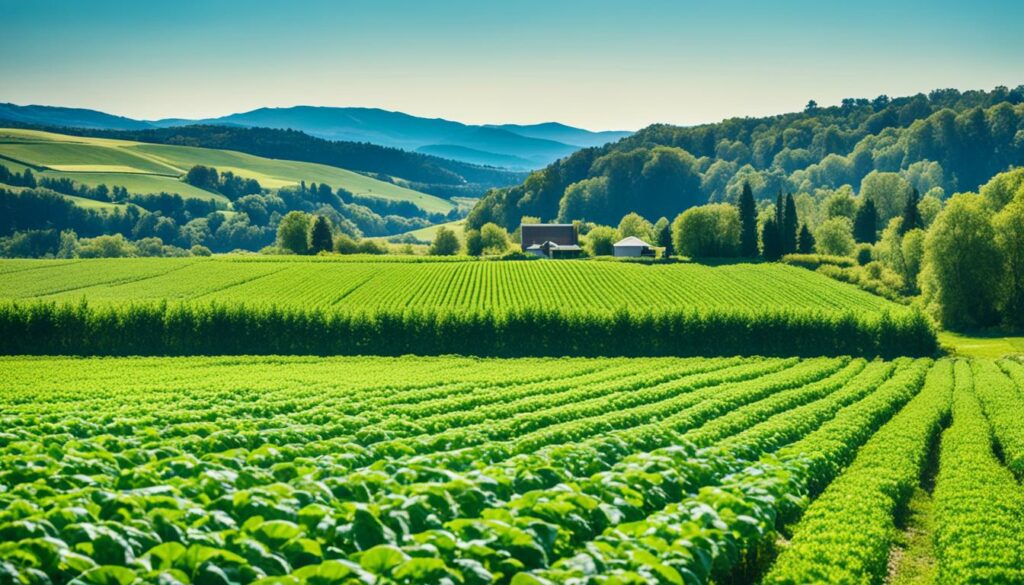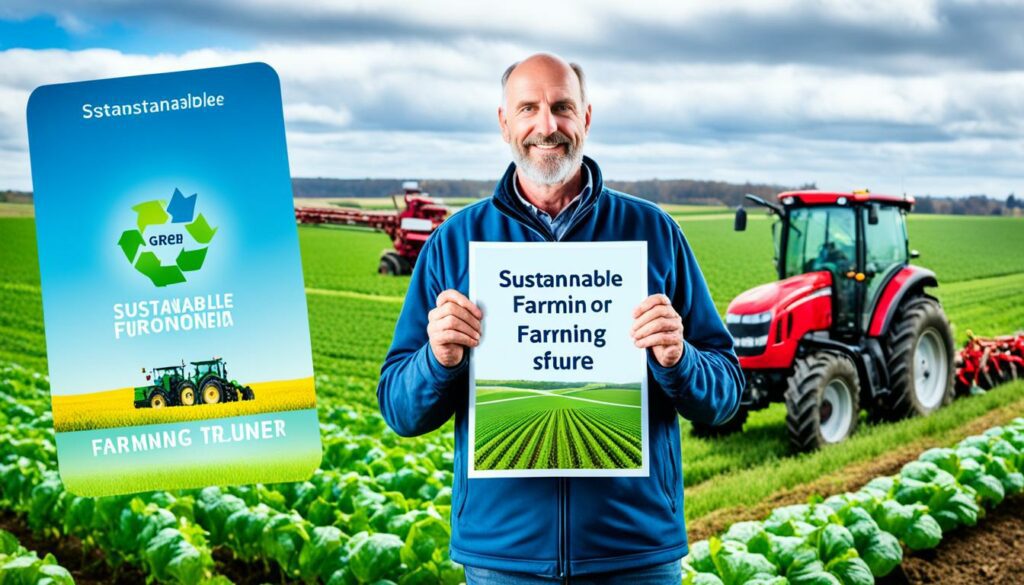Menu

Did you know that around 69% of England’s land is used for farming? This shows how important farming is. It not only provides food but also supports rural areas. Yet, the future of farming relies on being eco-friendly and following green rules.
Through the years, laws like the Clean Air Act of 1963 have been put in place to look after nature. For farmers, obeying these laws means more than just following rules. It means working in ways that are good for the environment and ensuring their farms last for a long time. Doing farming in an eco-friendly way is now a must, as people are more aware of the harm farming can do to nature.
When farmers use eco-friendly methods, they help their farms and the planet. These methods include improving the soil, saving water, and making the public like what they do more. They also get a chance to sell their products in new markets. So, using green methods means more than just doing good for nature. It helps farms do better as businesses, too.
Understanding how agricultural environmental policies developed is crucial. I will explain the history of these regulations. We will look into important laws that changed farming practices today.
Changes in how we view agriculture’s impact on the environment sparked these policies. Early on, global efforts were few, focusing on border water issues. The 1960s marked a turning point with the launch of environmentalism, thanks to Rachel Carson’s book.
Japan made significant steps with its pollution-control law in 1967. Then, the 1972 United Nations Conference solidified global environmental cooperation with the creation of UNEP.
Important laws have greatly affected modern agriculture. The Clean Air Act, for example, sets strict standards to reduce air pollution from vehicles and factories. This is crucial for our health.
The Clean Water Act and the Safe Drinking Water Act safeguard our water sources. They prevent pollution, ensuring water is safe for both drinking and farming.
There are also laws concerning waste. The CERCLA, for instance, manages hazardous waste disposal to stop environmental harm. The RCRA guides in handling waste thoroughly.
The EPA plays a vital role in enforcing these laws. It protects our environment and health. It also focuses on making sure everyone gets fair treatment under these regulations.
Sticking to sustainability laws in agriculture is very important today. These laws make sure farming can last for a long time. 87% of farmers follow these rules to keep the environment safe. This shows they know how crucial these rules are.

Ignoring these *contemporary eco regulations in agriculture* can lead to big fines. Farms that don’t follow environmental laws might be fined from $5,000 to $50,000. This can really hurt their finances. By following the rules, farms can avoid these big fines and also enjoy many benefits.
Thanks to these laws, 64% of farms have made great progress. They use less water and energy and their soil is healthier. Also, farms that are kind to the environment saw their crop production increase by 15% in five years. This proves that following these rules brings real advantages.
There are even government rewards for following the regulations. 78% of farms that stick to the rules get financial help. This makes ‘going green’ a smart move money-wise. Plus, more and more farmers are using high-tech gadgets to check if they are following the rules correctly. This shows the trend towards smart, rule-abiding farming is growing.
Following *contemporary eco regulations in agriculture* is beneficial. By doing so, farming businesses not only obey the law but set themselves up for success. Adding sustainable practices also helps protect nature and ensures farming can thrive for a long time.
Sticking to green laws helps farmers save money and gain. It cuts costs by being smart with resources. Plus, they can get money back by following these rules. It’s a win-win deal.
Managing farm resources well saves a lot of money. Farmers can find ways to use water and fertiliser better. They can also cut waste and get more crops grown. Using high-tech farming can help spend resources wisely.
Efficient irrigation can use half the usual water. This cuts water bills and saves a precious resource. Also, better soil care means more crops without needing as many chemicals. All this good work saves money, making farms more profitable.
Keeping the environment safe means farmers can get help. Governments and groups offer money for green farming. This aid lowers the costs of going green.
In the US, farmers can join programs like EQIP and CSP for support. These help pay for eco-farming and tech that helps nature. So, farmers can do the right thing for the planet while easing the cost.
The benefits of green farming are big, both for the wallet and the farm itself. Those who care for the environment boost their profits and health of their farm.
Sustainable farming helps the land and the wider environment in many ways. It boosts soil quality through methods like less ploughing and using natural mulch. This keeps the land productive for the long term.
It also helps save water. Drip irrigation, for example, uses water more wisely. This is key in sustaining our water sources for the future.

Sustainable farming lowers greenhouse gas emissions by actions like crop rotation. It fosters biodiversity and helps fight climate change. These methods make a farm a home for many different creatures.
There are economic gains too. Farming sustainably cuts costs using energy efficient tools. This includes things like solar panels. It also boosts the farm’s reputation for being eco-friendly.
Look at the table below. It shows the many upsides of going green in farming:
| Benefit | Detail |
|---|---|
| Cost Savings | Reduction in utility bills through energy-efficient measures. |
| Enhanced Brand Reputation | Positive perception among consumers and stakeholders. |
| Access to Financial Incentives | Support through grants and subsidies. |
| Increased Productivity | Enhanced employee engagement and satisfaction. |
| Regulatory Compliance | Avoidance of legal issues and penalties. |
Farming sustainably makes sense both morally and financially, given today’s eco-aware market. It protects nature while bringing in money and meeting laws. So, making farms greener is crucial for a successful future in agriculture.
Looking at how environmental rules are working in the real world can show us the big wins. It’s clear through examples from Switzerland and the United States how sticking to these laws boosts farm output and cuts down on costs. This shows that playing by the rules brings real benefits.
Switzerland is a shining example when it comes to green farming. Their tough environmental laws have pushed farmers to do more with less harm. It’s all helped cleaner air and water, and less pollution, especially in areas where it really counts.
Swiss farmers have proved that saving the planet can boost business. By saving resources and cutting pollution, they’ve not only got better crops but also spent less doing it. This success has made the country a top player in eco-friendly farming.
In the US, dairy farms are changing a lot because of new environmental rules. These cover things like keeping water and air clean. At first, folks were worried it would cost too much and hurt how much they could produce. But, new ways of working like trading pollution rights have shown promise.
For instance, trading sulfur pollution rights under the Clean Air Act has cut costs for many. These changes aren’t just good for the planet. They also help people stay healthier by fighting off pollution illnesses.
| Success Factors | Impact on Swiss Farming | Impact on US Dairy Farming |
|---|---|---|
| Enhanced Air and Water Quality | Significant improvements in pollution control | Reduction in airborne particulates saving lives |
| Economic Efficiency | Cost savings through sustainable practices | Lower compliance costs via market-based approaches |
| Health Benefits | Improved public health through cleaner environment | Prevention of millions of illnesses annually |
These stories really drive home why we need to stick to green standards. They show that keeping the planet safe also makes farms better off. By following the rules, we not only do our part for the Earth. We also find a path to farming that’s good for the long haul and for making money.
Environmental regulations, such as those from the EPA in the US, greatly affect technology in agriculture. The EPA, created in 1970, brought laws like the Clean Air and Clean Water Acts. These pushed the agricultural sector to change and come up with new ideas.
Businesses see benefits by following these rules, like better efficiency and less waste. This push to meet green standards encourages farmers to use new tech. Thanks to laws like the Safe Drinking Water Act, farmers work on better water management.
In China, the goal is to hit “peak carbon” by 2030 and be “carbon neutral” by 2060. Their Environmental Protection Tax Law from 2018 is pushing the agriculture field to make big tech jumps. Innovations not only help the planet but also boost business.
The Porter Hypothesis shows that strict rules can lead to economic gains through innovation. China’s success with these regulations supports this idea.
Studies in China have found a funky relationship between green rules and company innovation. Investment in R&D is key. It leads to new, smart farming methods, underlining the tie between rules and tech progress.

China is showing how important strong leadership is for innovation through the OANRA. This forward-thinking audit supports eco-friendly policies and speeds up tech progress.
| Region | Key Legislation | Impact on Innovation |
|---|---|---|
| United States | Clean Air Act, Clean Water Act | Promotes technological advancements in water and air quality management |
| China | Environmental Protection Tax Law | Drives innovation in eco-friendly farming practices and R&D investments |
| Multiple Chinese Provinces | OANRA | Strengthens leadership roles and accelerates enterprise innovation |
Looking at these instances, the impact of green rules on tech innovation in farming is clear. Such measures are crucial for sustainable and advanced agricultural methods.
It’s vital to make soil healthier and store carbon for lasting farming. This follows rules to protect nature while growing bountiful crops. Key ways include less ploughing, changing crops, and using certain plants to protect the ground. These moves boost soil life and safety against weather changes.
Doing less digging helps soil to stay healthy. It keeps the ground together and lets good bugs live there. Also, soil can hold more water and won’t wash away easily. In fact, farming this way can add up to three more tonnes of carbon per hectare each year. This is a big reason to follow green farming rules.
Changing crops and using plant covers are key for soil. These steps cut down on soil problems. They help nutrients keep flowing and stop bugs from becoming too much of a problem. Such methods are crucial for keeping the soil in top condition.
Cover crops grow for soil use, not food. They keep the ground covered, add more plant stuff, and stop the soil from washing away. Together with changing crops, they do a lot to keep the soil productive. They also help meet green rules for farming, keeping the land and air healthy.
| Practice | Benefits |
|---|---|
| Reduced Tillage | Preserves soil structure, boosts organic matter, and improves water retention |
| Crop Rotation | Optimises nutrient use, controls pests and diseases, and maintains soil fertility |
| Cover Crops | Prevents erosion, adds organic matter, and enhances soil structure |
Using these tricks helps farmers keep their soil well and follow green rules. It helps the planet by storing carbon and preserving earth. This way, everyone wins with a better, safer environment.
Improving water in farming is key for sustainable agriculture. Using water treatment controllers helps a lot. They’ve made big changes in cities worldwide. For example:

| City | Achievement |
|---|---|
| San Diego, USA | Reduced water waste by up to 20% |
| Amsterdam, Netherlands | Reduced use of chemicals by up to 50% |
| Beijing, China | Improved water treatment efficiency by up to 30% |
In Lithuania, they work hard to keep waters safe. They watch over chemicals and the earth closely. Good monitoring and protecting ways are key here.
Korea watches over many water spots. They check on water life and quality a lot. Using new tech, Germany maps and watches water closely. This helps with smart choices.
The EU and the US have strong rules to stop water pollution. They want to keep waters clean from harmful things. By following these rules, water stays safe.
Ireland and New Zealand have good plans for farming. They watch out for things that could harm water. These plans help keep water in good shape.
With the right tools and plans, we can make water better and save it. This is good for farming and nature. It helps us all live in a healthier world.
Farming greatly affects biodiversity in farming ecosystems and overall health. It is vital to protect habitats for a balanced environment.
Keeping landscapes in farming areas intact is very important. It helps many species thrive. This work by farmers supports the growth of local plants and animals. It also aids in controlling pests naturally and keeps soil and water clean.
Environmentally friendly farming helps pollinators and wildlife. It is crucial for a good and productive farm. Farming that follows green rules gives flowers, safe places to live, and no harmful chemicals. This makes pollinators and many animals thrive, boosting agriculture.
Protecting nature in farming areas and encouraging diversity is key. It helps wildlife and makes the food chain stronger. These sustainable methods are great for our environment and farming in the long run.
Complying with environmental laws has clear benefits, including market benefits of eco-regulation compliance. Businesses that follow these rules see better operational efficiency. They also produce less waste and perform better environmentally. This effort meets legal requirements and supports what the public thinks about green farming.

The EPA has played a big role in green action since 1970. It makes sure companies keep the environment and people’s health in mind. The EPA helps ensure companies use greener ways. Laws like NEPA make sure the public has a say in big environmental choices.
Another key idea is environmental justice. This means everyone should get the same care from environmental harm, no matter their wealth. International agreements also tackle big issues like climate change. This encourages everyone to work together globally.
Research shows that following the green rules helps companies avoid big problems. They won’t deal with as many legal, operation, or public relation hassles. These companies make more money in the long run. They also look good to customers who care about the environment. This boosts how the public sees them.
Being green also means being creative in business. It pushes companies to use resources efficiently and to think about the future. This focus can save them money and make them work better. It can also draw in more people who want to invest in, work for, or buy from these companies.
On the flip side, not following the rules can cause serious issues. Being sued or paying for environmental harm can hurt a business badly. So, keeping up with the green laws isn’t just about doing right by the planet. It’s also about staying relevant in the market.
| Benefits | Impact |
|---|---|
| Operational Efficiency | Increased through compliance |
| Reputation | Improved with public opinion on green agriculture |
| Legal Risks | Minimised |
| Market Opportunities | Expanded for compliant businesses |
Ignoring environmental rules can bring big legal and money problems for farmers. Tasks like meeting air and water quality standards are crucial. And if a farm doesn’t meet these, they could face big fines or even shut down.
The Clean Air Act and the Clean Water Act set firm rules. If a farm doesn’t follow them, the penalties can hit hard. This could mean paying large fines or dealing with unsafe pollutants.
Sticking to these rules keeps the environment and people safe. Breaking them leads to expensive legal fights and fines.
Farms need to adhere to laws like the Endangered Species Act. Breaking this law could result in needing to make things right for a long time.
The Toxic Substances Control Act and the NEPA also have strict rules. Not following means farms could have trouble staying in business and keeping their finances healthy.
| Regulation | Focus | Potential Penalties | Long-Term Implications |
|---|---|---|---|
| Clean Air Act (CAA) | Air Quality Standards | Penalties for exceeding pollutant limits | Ongoing liability for cleaner technologies |
| Clean Water Act (CWA) | Water Quality Standards | Fines for unlawful discharges | Cost of upgrading effluent treatment |
| CERCLA | Hazardous Waste Management | Liability for cleanup costs | Continuous monitoring obligations |
| ESA | Protection of Endangered Species | Restrictions on land use | Legal actions and species protection |
| TSCA | Chemical Substance Regulation | Non-compliance fines | Permanent record of infractions |
| RCRA | Waste Management Standards | Sanctions for improper disposal | Long-term waste management policies |
It’s crucial for farms to know these risks well. Whether facing fines or handling long legal battles, following the rules saves money and keeps the farm running smoothly.
The impact of climate change on farming is increasing, stressing the need for strong adaptive actions. Over 100 million Americans faced extreme weather in the last two years alone. This shows the urgent requirement for agricultural strategies to combat climate change. Such measures are essential to prevent losses that run into billions of dollars.
Important laws like the Bipartisan Infrastructure Law (BIL) and the Inflation Reduction Act (IRA) have allocated over $50 billion. The aim is to improve climate resilience in every US community. Executive Order 14096 also states that 40 percent of large Federal investments should benefit disadvantaged areas. These steps are key to creating resilience strategies that fit every farm’s need, regardless of its size or location.
In the last decade, the Department of Transportation (DOT) has shown how to make climate resilience part of their work. This includes planning and policy both at home and abroad. They are leading with a National Climate Resilience Framework. The 2021 Climate Action Plan calls this a “once-in-a-generation” chance. It sets out principles that stress using top science, protecting vulnerable groups, and saving the environment. Such a plan is crucial for farms to cut greenhouse gases and brace for future climate issues.
The Climate Action Plan also highlights the need for local, state, and regional transportation groups to support resilience. They must make sure their projects can handle the effects of climate change and teach their staff about these issues. This change is vital to protect farms, ensure they last, and help the agricultural sector face a challenging future.
Following these rules means farming that keeps going for the long term. It also helps the environment. Abiding by green standards helps farms grow steadily and helps the planet, too.
Farm rules started long ago to cut the bad effects of farming on nature. They started simple and now have grown to big laws for eco-friendly farming.
The EU’s farming policy, the US Clean Water Act, and local rules all aim to protect the environment. They help farms grow in a way that doesn’t harm the world around them.
These rules are key in keeping farms going now and in the future. With the growing need to protect nature and meet people’s expectations, sticking to these laws is essential.
Sticking to environmental standards saves money. It helps manage resources better, and farmers also get support in the form of money and benefits for being eco-friendly.
Practising sustainable farming keeps soil and water healthy and helps animals and plants. These benefits are vital for the land and the wildlife living on the farm.
In Switzerland, farms are doing better thanks to environmental rules. And in the US, dairy farms are managing their impact on the environment well. Both show how following green standards benefits farms.
Rules push for smarter ways to farm, leading to new techniques and technologies. These fresh ideas meet green standards and make farming more efficient.
These methods improve the soil and help farms last longer. With less tillage, the soil stays healthy. Rotating crops ensures the soil stays fertile. And cover crops protect the land.
Using smart ways to water crops, harvesting rainwater, and protecting water areas helps. These steps help use water wisely and keep it clean.
Farming in a green way helps keep nature’s homes safe. It helps all kinds of plants and animals thrive. And this makes the whole ecosystem healthier.
Farmers who follow the rules get a good name and new chances to sell their produce. People like to buy from farms that are kind to the planet. So, following these laws can boost a farm’s reputation.
Breaking the rules can lead to fines and other big problems. Not following the laws can be very costly and risky for farms.
Rules help farms get ready for climate changes and lower their bad effects on the environment. They guide farming in a way that’s good for the future of agriculture.